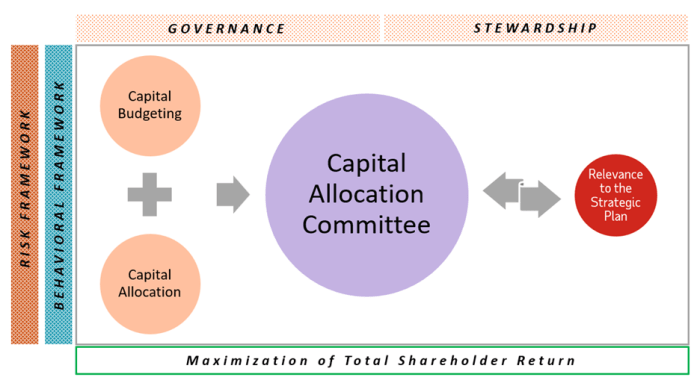
With Optimizing Capital Allocation at the forefront, this paragraph opens a window to an amazing start and intrigue, inviting readers to embark on a storytelling journey filled with unexpected twists and insights.
Capital allocation is a crucial aspect of business management, determining the success and growth of an organization. By strategically distributing resources, companies can maximize efficiency and profitability, leading to sustainable growth and competitive advantage.
Understanding Capital Allocation

Capital allocation is the process of distributing financial resources in a way that maximizes the value of a business. It involves determining where to invest funds based on the expected returns and risk associated with each opportunity.
Effective capital allocation is crucial for businesses as it directly impacts their growth, profitability, and overall success. By allocating capital efficiently, companies can optimize their resources, increase shareholder value, and achieve sustainable competitive advantages in the market.
Types of Capital Allocation Strategies
- Strategic Capital Allocation: Involves aligning capital investments with the long-term goals and objectives of the business. This strategy focuses on investing in projects that support the company’s core competencies and competitive advantage.
- Tactical Capital Allocation: Refers to short-term allocation decisions that aim to address immediate needs or opportunities. This strategy involves reallocating resources based on changing market conditions or unexpected events.
- Dynamic Capital Allocation: Combines strategic and tactical approaches by continuously adjusting capital allocation based on real-time data, market trends, and internal performance metrics. This agile strategy allows businesses to adapt quickly to changing circumstances and seize new opportunities.
Relationship between Capital Allocation and Business Performance
The way a company allocates its capital directly impacts its overall business performance. A well-defined capital allocation strategy can lead to increased revenue, improved operational efficiency, and higher return on investment. On the other hand, poor capital allocation decisions can result in wasted resources, missed growth opportunities, and reduced profitability.
Factors Influencing Capital Allocation Decisions
When businesses make decisions regarding capital allocation, several key factors come into play that can significantly impact their choices. These factors play a crucial role in determining how resources are allocated within a company.
Role of Risk Assessment
Risk assessment is a critical component of capital allocation decisions. Businesses need to evaluate the level of risk associated with different investment opportunities before allocating capital. By assessing the potential risks involved, companies can make more informed decisions and mitigate the chances of financial loss. Factors such as market volatility, economic conditions, and industry-specific risks all play a role in determining the overall risk profile of an investment opportunity.
Impact of Market Conditions
Market conditions have a direct impact on capital allocation strategies. Fluctuations in the market can influence the availability of investment opportunities, as well as the potential returns on those investments. Businesses need to adapt their capital allocation decisions based on current market conditions to maximize returns and minimize risks. Factors such as interest rates, inflation, and overall economic stability can all influence how businesses allocate their capital.
Optimizing Capital Allocation

Optimizing capital allocation is crucial for the success and growth of any organization. By efficiently allocating resources, companies can maximize their returns and minimize risks. Let’s explore some techniques and strategies to optimize capital allocation.
Capital Efficiency and Optimization
Capital efficiency plays a vital role in optimizing capital allocation as it focuses on getting the most out of the resources invested. By improving capital efficiency, organizations can enhance their overall performance and profitability.
- Implementing a robust financial planning and analysis system to track and analyze capital allocation decisions.
- Regularly reviewing and optimizing the capital structure to ensure the right mix of debt and equity.
- Utilizing sophisticated financial models to forecast cash flows and evaluate investment opportunities.
- Allocating resources based on the risk-return profile of different projects or investments.
Optimizing capital allocation requires a balance between risk and return, ensuring that resources are allocated to projects with the highest potential for value creation.
Successful Strategies for Capital Allocation Optimization
Here are some examples of successful strategies that companies have implemented to optimize capital allocation:
- Conducting regular portfolio reviews to reallocate resources to projects with higher returns.
- Using key performance indicators (KPIs) to measure the effectiveness of capital allocation decisions.
- Implementing a capital allocation framework that aligns with the company’s strategic objectives.
- Engaging in scenario analysis to assess the impact of different outcomes on capital allocation.
Capital Growth Strategies
Capital growth is the increase in value of a business’s capital over time, which is essential for ensuring the sustainability and competitiveness of the business in the long run. It allows companies to expand, invest in new opportunities, and withstand economic downturns.
Effective capital growth strategies are crucial for businesses to thrive and achieve their financial goals. By utilizing various strategies, businesses can maximize their returns and strengthen their financial position in the market.
Different Strategies for Capital Growth
- Increasing Sales and Revenue: One of the most common strategies for capital growth is to focus on boosting sales and revenue streams. By expanding customer base, improving marketing strategies, and introducing new products/services, businesses can generate more income.
- Cost Reduction and Efficiency Improvement: Another approach is to cut unnecessary costs, streamline operations, and enhance efficiency. By optimizing processes and reducing wastage, businesses can improve their profit margins and allocate more funds towards growth.
- Investing in Research and Development: Investing in R&D activities can lead to the creation of innovative products/services, which can drive growth and differentiation in the market. It allows businesses to stay ahead of competitors and attract more customers.
- Acquisitions and Partnerships: Mergers, acquisitions, and strategic partnerships can help businesses expand their market presence, acquire new technologies, or enter new markets. These strategic moves can accelerate growth and increase market share.
Relationship between Effective Capital Allocation and Sustainable Capital Growth
Effective capital allocation plays a crucial role in achieving sustainable capital growth for businesses. By allocating resources strategically to high-return projects or investments, businesses can maximize their capital growth potential. This ensures that the capital is utilized efficiently and generates long-term value for the company, leading to sustainable growth and profitability.
As we conclude our exploration of Optimizing Capital Allocation, it becomes evident that making informed decisions regarding resource allocation is paramount for businesses looking to thrive in a dynamic market environment. By implementing effective strategies and staying attuned to market conditions, organizations can achieve long-term success and resilience.
FAQ Guide
How does capital allocation impact business performance?
Capital allocation directly influences a company’s financial health and overall success by determining how resources are distributed to different projects or divisions.
What role does risk assessment play in capital allocation decisions?
Risk assessment helps businesses evaluate potential outcomes and uncertainties associated with different investment options, guiding them in making informed capital allocation choices.
Why is capital efficiency important in optimizing capital allocation?
Capital efficiency ensures that resources are utilized effectively, maximizing returns and minimizing waste, which is crucial for achieving optimal outcomes in capital allocation strategies.





